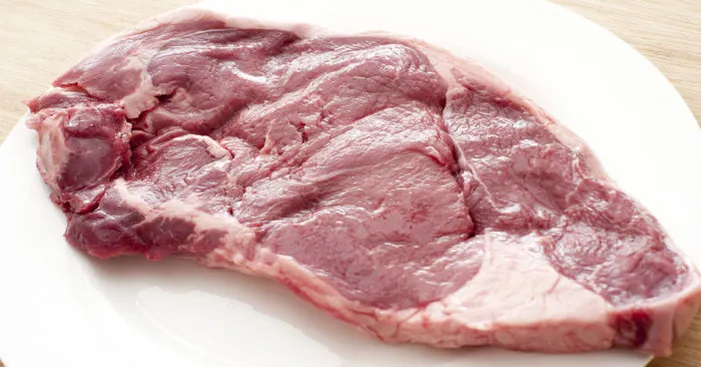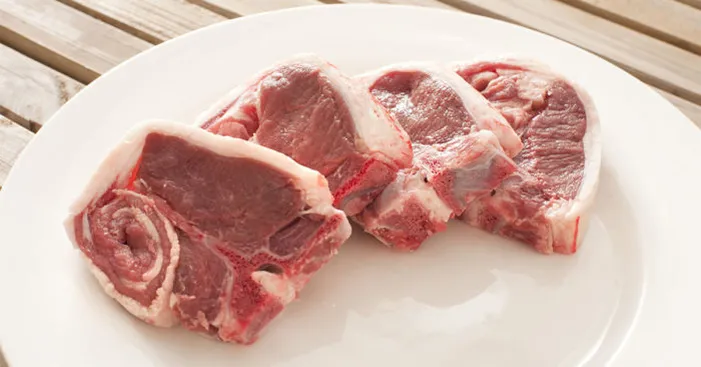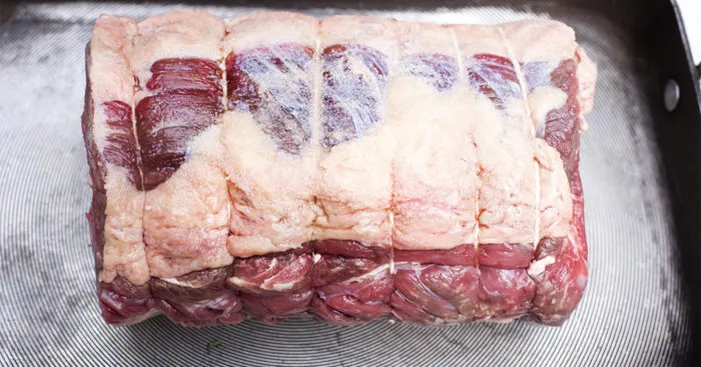Table of Contents

Lamb healthy and packed with essential nutrients our bodies need to function properly.
This delicious and nutritious protein source, enjoyed for centuries, offers not only a delightful taste but also a variety of health benefits.
In this blog post, we will explore the nutritional values of lamb meat and discuss the ways in which it can support a healthy diet.
From protein and iron to B vitamins and omega-3 fatty acids, lamb meat is a nutrient-dense food that can contribute to overall wellness.
Whether you’re looking to boost your energy levels, improve your cardiovascular health, or simply enjoy a delicious meal, lamb meat is an excellent choice.
So let’s dive in and learn more about this versatile and nutritious protein source!
Here’s why lamb is healthy:
Lamb is a red meat, a term people use to describe mammal meat that is richer in Iron than beef or chicken.
Due to its high content of myoglobin (iron and oxygen-binding protein), this type of meat turns red when we expose it to the air and that’s why we call it “red-meat”. (1)
Lamb is very rich in complete proteins, vitamins, and minerals which makes it a great asset to a healthy diet.
Here are the benefits of eating lamb:

Contains source of CLAs:
Conjugated linoleic acids (also referred to as CLA) are a group of fatty acids that comes from linoleic acid.
During the digestion process of ruminants (beef, deer, and lamb), they produce CLAs which are only found in the meat of these grass eating animals, as well as in their milk and dairy products.
Animal studies have shows that CLAs can prevent obesity by reducing the deposition of adipose cells (fat cells) and body fat. (2)
A regular consumption of CLAs has also shown that these subject animals have a lower risk of developing breast, skin, and colon cancer.
Finally, another animal study made on rats has shown that, after consuming CLAs, most rats had anti-hypertensive effects.
However, it is important to mention that all these CLAs benefits have been only shown during animal studies, and we still need to confirm them on humans.
This is why researchers are very cautious about recommending the consumption of CLAs to face health issues.
Furthermore, the vast majority of the CLAs studies were conducted using supplements, in which therapeutic effects have been seen at daily doses of 4g to 7g of CLAs.
Few studies have been done using actual CLAs found in lamb, but nothing is confirmed yet.
It should also be noted that lamb contains 10mg to 15mg of CLAs per 100g, and that is very low compared to the necessary daily dose used in animal studies.
If the sheep are fed only grass, the proportion of CLAs becomes higher, and eating lamb meat will improve muscle mass, prevent cancer (especially breast cancer), and promote weight loss. (3)
Enhances brain function:
The nervous system is responsible for the function of all body parts since it controls the entire body.
To do this, it requires a regular supplement of the vitamin B group and any deficiency leads usually to imbalance symptoms including laziness, lack of focus, and increased nerve tension.
Lamb is a great source of vitamin B12 and 3.5 ounces (100g) of lamb provides 35% of the daily recommended value of this vitamin.
Studies have shown that 15% of people suffer from vitamin B12 deficiency, and in other searches, the percentage was even higher with up to 40% of people suffering a lack of vitamin B12. (4)
Also, B12 plays a key role in red blood cell production, nerve cell health, and anemia prevention.
It also maintains skin health, prevents excessive thinness, prevents depression and mood swings, strengthens mental abilities, and maintains the integrity of body cells and connective tissues.
Boosts the immune system:
This type of meat is very rich in Zinc, a mineral element found in every cell in the body.
Zinc is essential for our immunity system, wound healing, DNA, and protein formation, as well as maintaining the production of the testosterone hormone.
A person with zinc deficiency is proven to be more vulnerable to infectious diseases starting from common colds to pneumonia. (5)
Eating 3.5ounces (100g) of lamb provides 50.2% of the daily recommended value in Zinc.
Improves physical performance:
It’s not just because it helps maintain muscle mass, but lamb stimulates muscle function.
One of the amino acids found in lamb is beta-alanine and it helps in the production of carnosine, a compound essential for muscle endurance.
Beta-alanine is mostly found in large quantities in meats such as beef, pork, and lamb.
Studies have shown that high levels of carnosine in human muscles is associated with reduced fatigue and improved physical performance. (6)
On the other hand, a diet low in beta-alanine, such as vegetarian/vegan diets, can reduce muscle carnosine levels over time.
It has been shown that high beta-alanine supplements intake for 5 to 10 weeks results in a 40% to 80% increase in the amount of carnosine in the muscles. (7)
Athletes and people who are wishing to have a boost in their physical performance whether, for the gym, bedroom or daily chores tasks should definitely consider consuming lamb or foods that are rich in beta-alanine.
Offers protein:
Like other animal proteins, lamb provides a complete protein because it contains all the 9 essential amino acids needed for a proper body functioning. (8)
This is not the case for plant-based protein derived from vegetables as they mostly lack some essential amino acids.
3.5 ounces of lamb provides your body with 28.3g of complete protein essential to repair damaged tissues, feel energetic and build muscle mass.
Provides Iron:
Lamb contains more iron than chicken and fish, with 12% of the daily recommended value of Iron per 3.5 ounces (100g) of lamb. (9)
This type of iron found in lamb is considered quality Iron (heme Iron), as 40% of it is easily absorbed as soon as you consume it.
Eating lamb in moderate doses helps treat Iron deficiency and anemia symptoms.
Have you ever wondered why with most types of meat we add lemon juice?
One of the reasons is because Vitamin C found in lemon juice helps our bodies absorb iron faster.
Lamb is healthy but an over-consumption comes with side-effects:

Lamb has many benefits and nutrients essential for a proper body functioning.
However, consuming too much of anything could be dangerous for our health as we need a balanced diet with moderate doses.
Some of the risks of eating too much lamb are potential heart disease and colon cancer.
Some studies indicate that the risk of eating too much red meat differs from one type to another. (10)
Furthermore, even the way the red meat is manufactured, refined, or smoked red meat, known as processed meat, can have additional risk for its consumers.
Among those risks we mention:
Heart disease:
Although not confirmed, but some experts link this risk with the amount of saturated fat found in lamb.
Eating large quantities of lamb can raise the cholesterol level in the blood and that leads to cardiovascular problems. (11)
Cancer:
New research shows that consuming red meat on a regular basis can increase the risk of cancer. (12)
For the people who consume processed lamb meat regularly, these studies have shown an increased risk of developing colon or prostate cancer.
Eating too much lamb:
This is very scary, but we should consider that these same studies have been conducted based on the consumption of large quantities of red meat with no other ingredients.
Lamb should be completely avoided by those who suffer from obesity, kidney stones, and gout.
It is recommended to eat lamb grilled as it is the healthiest way to cook it compared to other cooking methods.
Also, the neck and back are the most recommended parts as they contain the lowest amount of fat.
However, most of the people who eat lamb usually consume it with vegetables and that helps balance the diet and avoid accumulations of free radicals and cholesterol in the blood.
The same studies have also shown that the recommended intake of lamb does not harm the body.
Experts recommended eating lamb not more than once or twice a week.
According to the BBC, 70 grams of lamb is a healthy amount that will provide benefits without health risks. (13)
Tips to buy healthy lamb meat:

Lamb meat can easily go bad, so it must have healthy characteristics that distinguish good meat from a perished one.
When you are purchasing lamb meat make sure that: (14)
- It is free from unpleasant odor especially in the parts close to the bone.
- The texture of the meat is solid and intact, to check that gently press the meat with a finger and make sure it doesn’t leave a trace once you take off your finger.
- The flesh looks dark red or pinkish-red, depending on the size and age of the sheep.
It should definitely be free of blue spots. - The fat color should be kind of yellow.
Conclusion:

Lamb is red meat that comes from young sheep.
It is called red meat because it’s high in myoglobin which turns red once exposed to air.
In addition to its high-quality protein, lamb is also a great source of many vitamins and minerals mostly Iron, Vitamin B12, and Zinc.
Regular and moderate consumption of lamb stimulate muscle growth, boost your physical performance and help prevent anemia.
However, eating too much lamb can cause side effects such as heart diseases and cancer.
Overripe lamb meat consumption can be harmful as the heterocyclic amines (type of carcinogen) form when this meat is exposed to extremely high temperatures. (15)
Finally, moderate consumption of not more than 70g of lamb meat two or three times a week is completely safe and will provide your body with all the benefits you can get from lamb.
References:
(1): The color of meat depends on myoglobin: Part 1 – MSU Extension
(2): Antiobesity Mechanisms of Action of Conjugated Linoleic Acid (nih.gov)
(3): Conjugated Linoleic Acid (CLA) in Animal Production and Human Health (psu.edu)
(4): Vitamin B12 deficiency in the elderly – PubMed (nih.gov)
(5): Zinc and respiratory tract infections: Perspectives for COVID-19 (Review) (nih.gov)
(6): Carnosine – an overview | ScienceDirect Topics
(7): Effects of Beta-Alanine on Muscle Carnosine and Exercise Performance:A Review of the Current Literature (nih.gov)
(8): Amino acids in sheep production (fbscience.com)
(9): Meat That Contains High Iron | Healthy Eating | SF Gate
(10): Is Eating Red Meat Bad For You? – Scripps Health
(11): Lamb and Cholesterol: Know the Facts (healthline.com)
(12): Consumption of red meat and processed meat and cancer incidence: a systematic review and meta-analysis of prospective studies – PubMed (nih.gov)
(13): How safe is eating meat? – BBC News
(14): How to Purchase and Prepare Lamb | MyRecipes
(15): Chemicals in Meat Cooked at High Temperatures and Cancer Risk – National Cancer Institute
